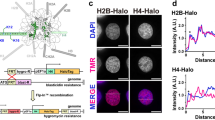Abstract.
In order to define a functional human centromere sequence, an artificial chromosome was constructed as a reproducible DNA molecule. Mammalian telomere repeats and a selectable marker were introduced into yeast artificial chromosomes (YACs) containing alphoid DNA from the centromere region of human chromosome 21 in a recombination-deficient yeast host. When these modified YACs were introduced into cultured human cells, a YAC with the alphoid DNA from the α21-I locus, containing CENP-B boxes at a high frequency and a regular repeat array, efficiently formed minichromosomes that were maintained stably in the absence of selection and bound CENP-A, CENP-B, CENP-C and CENP-E. The minichromosomes, 1–5 Mb in size and composed of multimers of the introduced YAC DNA, aligned at metaphase plates and segregated to opposite poles correctly in anaphase. Extensive cytological analyses strongly suggested that the minichromosomes had not acquired host sequences and were formed in all cases by a de novo mechanism. In contrast, minichromosomes were never produced with a modified YAC containing alphoid DNA from the α21-II locus, which contains no CENP-B boxes and has a less regular sequence arrangement. We conclude that α21-I alphoid DNA can induce de novo assembly of active centromere/kinetochore structures on minichromosomes.
Similar content being viewed by others
Author information
Authors and Affiliations
Additional information
Received: 22 August 1998 / Accepted: 28 August 1998
Rights and permissions
About this article
Cite this article
Masumoto, H., Ikeno, M., Nakano, M. et al. Assay of centromere function using a human artificial chromosome. Chromosoma 107, 406–416 (1998). https://doi.org/10.1007/s004120050324
Issue Date:
DOI: https://doi.org/10.1007/s004120050324




